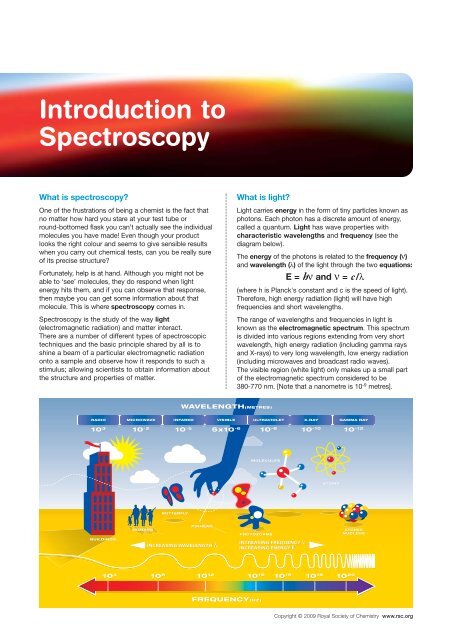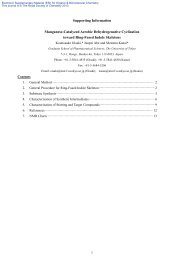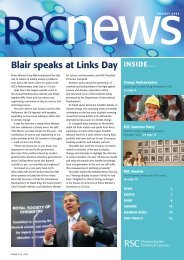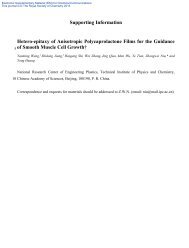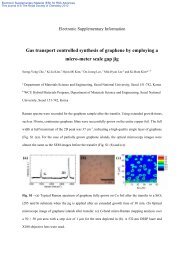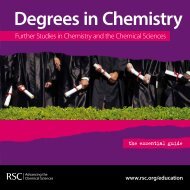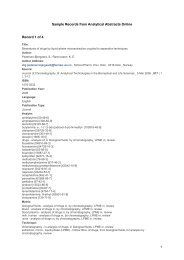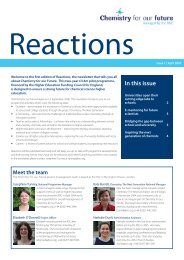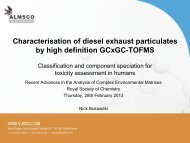Spectroscopy in a Suitcase - Royal Society of Chemistry
Spectroscopy in a Suitcase - Royal Society of Chemistry
Spectroscopy in a Suitcase - Royal Society of Chemistry
You also want an ePaper? Increase the reach of your titles
YUMPU automatically turns print PDFs into web optimized ePapers that Google loves.
Introduction to<br />
<strong>Spectroscopy</strong><br />
What is spectroscopy?<br />
One <strong>of</strong> the frustrations <strong>of</strong> be<strong>in</strong>g a chemist is the fact that<br />
no matter how hard you stare at your test tube or<br />
round-bottomed flask you can’t actually see the <strong>in</strong>dividual<br />
molecules you have made! Even though your product<br />
looks the right colour and seems to give sensible results<br />
when you carry out chemical tests, can you be really sure<br />
<strong>of</strong> its precise structure?<br />
Fortunately, help is at hand. Although you might not be<br />
able to ‘see’ molecules, they do respond when light<br />
energy hits them, and if you can observe that response,<br />
then maybe you can get some <strong>in</strong>formation about that<br />
molecule. This is where spectroscopy comes <strong>in</strong>.<br />
<strong>Spectroscopy</strong> is the study <strong>of</strong> the way light<br />
(electromagnetic radiation) and matter <strong>in</strong>teract.<br />
There are a number <strong>of</strong> different types <strong>of</strong> spectroscopic<br />
techniques and the basic pr<strong>in</strong>ciple shared by all is to<br />
sh<strong>in</strong>e a beam <strong>of</strong> a particular electromagnetic radiation<br />
onto a sample and observe how it responds to such a<br />
stimulus; allow<strong>in</strong>g scientists to obta<strong>in</strong> <strong>in</strong>formation about<br />
the structure and properties <strong>of</strong> matter.<br />
What is light?<br />
Light carries energy <strong>in</strong> the form <strong>of</strong> t<strong>in</strong>y particles known as<br />
photons. Each photon has a discrete amount <strong>of</strong> energy,<br />
called a quantum. Light has wave properties with<br />
characteristic wavelengths and frequency (see the<br />
diagram below).<br />
The energy <strong>of</strong> the photons is related to the frequency (m)<br />
and wavelength (l) <strong>of</strong> the light through the two equations:<br />
E=hm and m = c /l<br />
(where h is Planck's constant and c is the speed <strong>of</strong> light).<br />
Therefore, high energy radiation (light) will have high<br />
frequencies and short wavelengths.<br />
The range <strong>of</strong> wavelengths and frequencies <strong>in</strong> light is<br />
known as the electromagnetic spectrum. This spectrum<br />
is divided <strong>in</strong>to various regions extend<strong>in</strong>g from very short<br />
wavelength, high energy radiation (<strong>in</strong>clud<strong>in</strong>g gamma rays<br />
and X-rays) to very long wavelength, low energy radiation<br />
(<strong>in</strong>clud<strong>in</strong>g microwaves and broadcast radio waves).<br />
The visible region (white light) only makes up a small part<br />
<strong>of</strong> the electromagnetic spectrum considered to be<br />
380-770 nm. [Note that a nanometre is 10 -9 metres].<br />
WAVELENGTH(METRES)<br />
RADIO<br />
MICROWAVE<br />
INFARED<br />
10 3 10 -2<br />
10 -5 VISIBLE<br />
5x10 -6<br />
0 -6<br />
10 -8 10 -10 10 -12<br />
ULTRAVIOLET<br />
X-RAY<br />
GAMMA RAY<br />
MOLECULES<br />
ATOMS<br />
BUTTERFLY<br />
BUILDINGS<br />
HUMANS<br />
PINHEAD<br />
INCREASING WAVELENGTH l<br />
PROTOZOANS<br />
INCREASING FREQUENCY m<br />
INCREASING ENERGY E<br />
ATOMIC<br />
NUCLEUS<br />
10 4 10 8 10 12 10 15 10 16 10 18 10 20<br />
FREQUENCY(HZ)<br />
Copyright © 2009 <strong>Royal</strong> <strong>Society</strong> <strong>of</strong> <strong>Chemistry</strong> www.rsc.org


